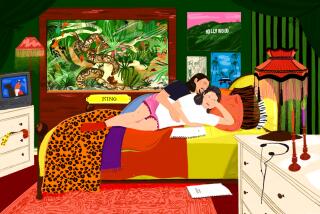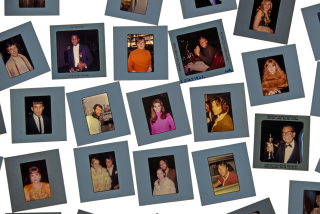Postscript
- Share via
In the mid-1930s--over drinks in front of the massive stone fireplace in his redwood mansion in the San Bernardino Mountains--actor Walter Huston spent hours regaling a young writer friend with tales of his early years in show business.
John Weld was enthralled.
Huston had spent time as a song-and-dance man in vaudeville and arrived in Hollywood via Broadway. At the time he was reminiscing with Weld, Huston was considered one of America’s finest actors; his son, John, hadn’t yet made his mark on Hollywood as a director.
Weld proposed writing Huston’s autobiography, an “as told to” book that would capture the veteran actor’s storytelling flair.
But in 1938, after an editor at Doubleday told Weld that biographies of actors and actresses just aren’t profitable, Weld abandoned the project. The unfinished manuscript was stuffed into a filing cabinet, where it languished for 60 years, leaving Huston’s life story untold.
Until now.
Thanks to the serendipitous discovery of Weld’s manuscript by a fellow biographer who found a publisher for Weld, “September Song: An Intimate Biography of Walter Huston” ($39.95) has just been published by Scarecrow Press.
And Weld, now 93 and living in an apartment in a Laguna Hills retirement home, couldn’t be happier.
“It’s something that is done, and I’m very pleased with it,” he said. “It seemed like it was never meant to be.”
“We’re both delighted,” said Katy, 86, Weld’s wife of 61 years, who helped edit her husband’s rewritten and expanded manuscript and typed it into their computer.
The title “September Song” is borrowed from the famous tune Huston sang during his critically acclaimed performance in the musical “Knickerbocker Holiday” on Broadway.
Today, Huston is probably best known for his role as the grizzled old prospector in “The Treasure of the Sierra Madre,” the classic 1948 Humphrey Bogart movie directed by Huston’s son, John. Both Hustons earned Oscars for their efforts, John for best direction and screenplay; Walter for best supporting actor.
Among Walter Huston’s other career highs: playing the title role in D.W. Griffith’s 1930 film “Abraham Lincoln,” the title role in “Dodsworth”--both on Broadway and in director William Wyler’s classic film--and co-starring with James Cagney in “Yankee Doodle Dandy.”
Then there was his 90-minute visit with President Franklin Roosevelt in the White House after which Roosevelt told the actor, “Now that you know where we live, please come back.”
The book also bears witness to the close relationship the author had with Huston, who was 21 years Weld’s senior.
“He was just about as fine a fellow as you could find,” Weld said. “I never had a father, because mine had died when I was 6 months old.” So, he added with a smile, “I adopted him.”
Huston, in fact, came to regard Weld as a son. Whenever he introduced Weld, he would say, “I have two sons, both named John.”
“September Song,” which is part of the Scarecrow Filmmakers Series, isn’t Weld’s first book.
He’s had 10 other fiction and nonfiction books published, including “Don’t You Cry for Me,” a 1940 novel based on the Donner Party. (His editor at Scribner’s was the legendary Maxwell Perkins.) Weld’s most recent book is “Laguna, I Love You,” a 1996 collection of columns he wrote while he was editor and publisher of the old Laguna Beach Post in the 1950s and ‘60s.
The Birmingham, Ala.-born Weld, who arrived in Hollywood three weeks shy of his 18th birthday, worked several years as a stunt man and stunt double for the likes of Tom Mix and John Barrymore.
But in 1926, with an introduction from Hollywood columnist Louella Parsons, Weld was hired as a reporter for the New York American. A year later, he hopped a freighter to France, where he landed a job on the Paris Herald.
It was at a dinner party in Paris in 1931 that Weld met Nan Sunderland, the tall, auburn-haired actress who would become Walter Huston’s third wife and would later introduce him to Huston.
Although Sunderland was engaged to Huston, she had traveled to Europe while he was in the midst of getting a divorce from his second wife.
After the dinner party, the hostess asked Weld if he would escort Sunderland back to her hotel. Once in the cab, Sunderland turned his face with her hands and kissed him on the lips.
“There,” she said. “That’s for taking me home.”
Shocked, then emboldened, Weld said he responded by saying, “One kiss deserves another.”
And so, Weld recalled, “I became her companion all the time she was in Paris. We had quite a love affair.”
Once Huston’s divorce became final, Weld said, “he wired Nan and said, ‘The coast is clear. Come home.’ So she did, and I bid her goodbye.”
It was the end of their affair but not their friendship. They met again in Hollywood a few months later, after Weld had been hired by Columbia studios to write a screenplay of a novel he wrote while in Paris about his experiences as a Hollywood stuntman.
Weld and Huston hit it off as soon as they met. “We turned out to be fast friends,” Weld said.
Indeed, after losing his studio job and being turned down for a Guggenheim Foundation grant he’d wanted to get so he could work on his novel about the Donner Party, Huston told Weld, “I’ll be your Guggenheim.”
So in exchange for handling Huston’s fan mail, Weld moved into Huston House, the secluded mountaintop mansion the actor and his wife had just built near Running Springs.
When Weld wasn’t working on his novel--and Huston wasn’t down the mountain at MGM, where he was under contract--the two men swam, rode horses, skied and played tennis and cards together.
And, come cocktail hour, they would sit in the living room, where Huston would tell his show business tales.
*
Weld’s manuscript might have languished forever in his filing cabinet if it hadn’t been for writer James Curtis of Brea.
In 1995, while doing research for his forthcoming biography of director James Whale, Curtis examined Universal Studios’ records of Whale’s 1933 film of H.G. Wells’ “The Invisible Man.”
At least a dozen writers, including Preston Sturges and John Huston, had written treatments or screenplays based on the book. All the names were recognizable except one: John Weld, whose treatment had been the only one approved by Wells himself.
Shortly thereafter, Curtis received a mailing from the Authors Guild listing the names and phone numbers of members of a new committee he had joined. Included on the list: John Weld.
“I thought, ‘That can’t be the same man,’ ” said Curtis, 44.
He phoned Weld and set up a meeting to discuss Weld’s work on “The Invisible Man.”
At the end of their talk, Curtis noticed a still life of watermelons on the living room wall. Weld told him it had been painted by John Huston.
“Did you know him?” Curtis asked.
“He was like a brother to me,” said Weld, telling Curtis the story of how he came to know John Huston’s father.
Given Huston’s reputation as an actor, Curtis told Weld it was surprising that no biography had been written.
“Actually, we wrote one in the ‘30s but couldn’t get anybody interested in it at the time,” Weld replied. Then he brought out the old manuscript, on which both Huston and his wife had made handwritten corrections.
As Curtis recalls: “I said, ‘John, this is terrific. It should be published. Have you thought about completing it?’ It only went up to 1938, and Walter lived until 1950. He said, ‘If you find me a publisher, I’ll finish it.’ ”
Curtis, who linked Weld up with Scarecrow Press and did some library research for him, said he’s delighted to see the Huston book in print.
“It’s really unusual to be able to retrieve the thoughts and recollections of someone who’s been dead for 50 years as we were able to by virtue of that manuscript,” he said. “This probably makes John the oldest biographer. I’m not sure there are other people 93 years of age writing biographies out there.”
Among the material not included in Weld’s original manuscript is his introduction, in which he discusses his brief affair with Nan Sunderland in Paris.
Weld first wrote about it in “Young Man in Paris,” his 1985 memoir. Although he sent John Huston a copy of the memoir, Huston never commented on it.
But shortly before the director died in 1987, the Welds visited their old friend. He was staying at actor Burgess Meredith’s house in Malibu, and at one point during their visit, as Weld writes, Huston took Weld aside.
“Did you ever tell Dad about your affair with Nan in Paris?” he asked.
“No,” Weld said. “It was past history and never renewed. I found no cause to.”
More to Read
Sign up for our Book Club newsletter
Get the latest news, events and more from the Los Angeles Times Book Club, and help us get L.A. reading and talking.
You may occasionally receive promotional content from the Los Angeles Times.










